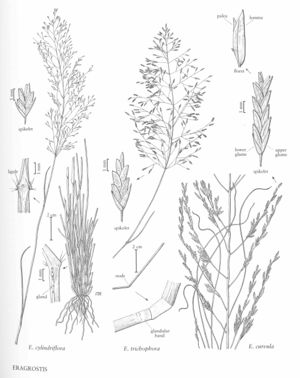Difference between revisions of "Eragrostis trichophora"
FNA>Volume Importer |
imported>Volume Importer |
||
| (7 intermediate revisions by 2 users not shown) | |||
| Line 3: | Line 3: | ||
|accepted_authority=Coss. & Durieu | |accepted_authority=Coss. & Durieu | ||
|publications= | |publications= | ||
| + | |special_status={{Treatment/ID/Special_status | ||
| + | |code=I | ||
| + | |label=Introduced | ||
| + | }} | ||
|basionyms= | |basionyms= | ||
|synonyms={{Treatment/ID/Synonym | |synonyms={{Treatment/ID/Synonym | ||
|name=Eragrostis atherstonei | |name=Eragrostis atherstonei | ||
| − | |authority= | + | |authority= |
| + | |rank=species | ||
}} | }} | ||
|hierarchy=Poaceae;Poaceae subfam. Chloridoideae;Poaceae tribe Cynodonteae;Eragrostis;Eragrostis trichophora | |hierarchy=Poaceae;Poaceae subfam. Chloridoideae;Poaceae tribe Cynodonteae;Eragrostis;Eragrostis trichophora | ||
| Line 28: | Line 33: | ||
-->{{#Taxon: | -->{{#Taxon: | ||
name=Eragrostis trichophora | name=Eragrostis trichophora | ||
| − | |||
|authority=Coss. & Durieu | |authority=Coss. & Durieu | ||
|rank=species | |rank=species | ||
| Line 35: | Line 39: | ||
|basionyms= | |basionyms= | ||
|family=Poaceae | |family=Poaceae | ||
| + | |illustrator=Linda A. Vorobik;Cindy Roché | ||
| + | |illustration copyright=Utah State University | ||
|distribution=Md. | |distribution=Md. | ||
|reference=None | |reference=None | ||
|publication title= | |publication title= | ||
|publication year= | |publication year= | ||
| − | |special status= | + | |special status=Introduced |
| − | |source xml=https:// | + | |source xml=https://bitbucket.org/aafc-mbb/fna-data-curation/src/200273ad09963decb8fc72550212de541d86569d/coarse_grained_fna_xml/V25/V25_115.xml |
|subfamily=Poaceae subfam. Chloridoideae | |subfamily=Poaceae subfam. Chloridoideae | ||
|tribe=Poaceae tribe Cynodonteae | |tribe=Poaceae tribe Cynodonteae | ||
Latest revision as of 17:55, 11 May 2021
Plants perennial; cespitose, stoloniferous, forming innovations near the base. Culms 30-70 cm, erect, geniculate, or prostrate, often rooting at the lower nodes, glabrous, with a ring of glands below the nodes. Sheaths glabrous or with scattered papillose-based hairs over most of the surface, apices pilose, hairs 1-4 mm, a ring of oblong glands sometimes present below the collar; ligules 0.2-0.5 mm; blades 1.4-10 cm long, 2-3 mm wide, flat to involute, sparsely hairy with papillose-based hairs, abaxial surfaces often with glandular dots. Panicles 5-20 cm long, 2-7 cm wide, narrowly ovate, open; primary branches 2-7 cm, diverging 10-70° from the rachises, lowest branches whorled, naked proximally, bases with a glandular band; pulvini hairy; pedicels 0.3-3.3 mm, glandular. Spikelets 4-5.4 mm long, 1-1.5 mm wide, linear-lanceolate, plumbeous to greenish-gray, with 3-5 florets; disarticulation acropetal, paleas persistent. Glumes subequal, 1.4-1.8 mm, ovate-lanceolate, membranous; lemmas 1.5-1.8 mm, ovate, membranous, often hyaline, lateral veins inconspicuous, apices obtuse to acute; paleas 1.3-1.7 mm, hyaline, bases not projecting beyond the lemmas, apices obtuse; anthers 3, 0.7-1 mm, purplish. Caryopses 0.6-0.8 mm, ovoid, terete to dorsally compressed, shallowly grooved adaxially, translucent, mostly whitish to light brown, bases often greenish. 2n = unknown.
Discussion
Eragrostis trichophora is native to Africa, where it often grows in moist, disturbed or overgrazed sites. It has been collected from disturbed sites at Canton, Maryland.
Selected References
None.
